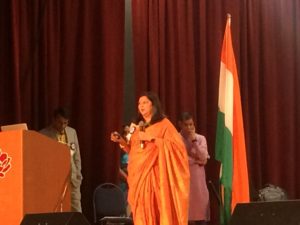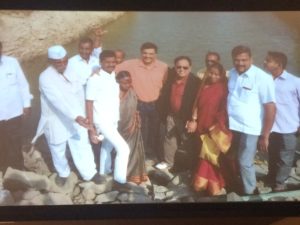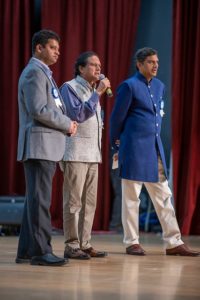
LAKSHMI IYER
India Post News Service
MILIPITAS, California: Overseas Volunteers for a Better India (OVBI), an organization that is an offshoot of Sri Sri Ravi Shankar’s Art of Living Foundation, held their annual fundraiser at the India Community Center (ICC) on Los Coches Street in Milpitas, California, September 15.
OVBI has been a champion in the cause of solving rural India’s dire water issues. It was established recently in 2016. In a short span of three years, the fledgling organization has already made 105 villages water independent, thanks to its dedicated team of volunteers who donate their time, energy and resources – financial and intellectual – selflessly, while holding day jobs as engineers, senior executives and entrepreneurs in Silicon Valley.
California State Assembly member Ash Kalra was present at the event and said a few words expressing appreciation for the work that OVBI is doing.
The extent of the water crisis facing Indian cities and villages was illustrated when B.V. Jagadeesh, the co-chair of OVBI Water, mentioned in his address, “Chennai was declared in June of this year as a zero water state.”
The capital city of the southern state of Tamil Nadu has long had water woes but now, things have reached an extreme level.
“The water table in some of these cities is really going so low, it is scary. And Chennai is just the beginning. There are many, many, many other cities in the pipeline, which is sort of unfortunate,” Jagadeesh said.

However, he believes that these are man-made problems and can be addressed. He cited the example of Israel, which receives far less rainfall than some of the most drought-prone regions of India, yet is water-sufficient.
Insufficient rainwater harvesting and water mismanagement have resulted in the dire shortage of this life-giving resource.
Jagadeesh introduced Raju Reddy, an entrepreneur, philanthropist and CEO of Sierra Electric, and a co-founder of an organization called Kakatiya Sandbox, which is involved in helping farmers build solutions for their water problems in association with the Deshpande Foundation.
A sandbox is a system that brings together many villages and people with the expertise and resources to work on a particular problem. Like a software project, the solutions that work in a sandbox can be replicated on a larger scale. This project is named after the Kakatiya dynasty that ruled a large part of southern India and parts of Maharashtra from the 11th to 13th centuries. They were among the most progressive rulers.
In his address, Reddy shared his thoughts on the problems facing rural India.
“As you all know, there is a variety of problems, which also means there are many opportunities, whether it is access to basic education, health or a multitude of things. I often feel that the two biggest issues of urgency is access to water and clean air. Those are, in my mind, when I visit all these places, you know, these are the most pressing issues.”

Elaborating on the vision of the sandbox project, Reddy said: “If we combine the compassion of the nonprofit with the execution excellence of the for-profit world, we can produce outstanding results.”
Speaking about scale, he acknowledged that there were many people doing wonderful work in different areas in India. However, to have a really significant impact, it is required to bring a lot of people and resources together. That’s where the sandbox concept comes in.
“Typically, in a sandbox, we have 10 million population, so the idea is if we have 20 such ecosystems, we have 200 million and over a period of time, considering this is all rural area, this is about 25 per cent of India’s rural population. So that’s kind of the idea behind that.”
Through this initiative, the team has helped build farm ponds in many farmers’ lands to capture rainwater and this instills in the farmers a sense of responsibility and ownership.
Mohan Trikha, chairman of OVBI Water, narrated the story of his journey with the organization.
“Two-three years ago, our guru, Sri Sri Ravi Shankar said, ‘Apne desh ke liye kuchch karo (Do something for your country).’ And that started me thinking – what can I do sitting here?”
Heeding an inner call, Trikha decided to go to Latur, one of Maharashtra state’s worst drought-affected districts. He went with Nagaraj, his mentor.

He shared with the audience the emotional encounter he had with a farmer there, Gaikwad, who said, “Saheb, paani de do. Kuchh aur nahin chaahiye (Sir, give us water. We don’t want anything else)”.
Solving the water crisis in villages helps resolve a host of other socio-economic problems as well.
OVBI is now on the cusp of turning around 500 villages. There are dedicated project managers who are in charge of different regions.
One of them, Deepak, who is in charge of projects in Maharashtra, gave a presentation that showed villagers’ hard at work in building structures to shore up water and performing other necessary tasks.
Deepak shared his own story in which water woes played a major role in the migration of his family of farmers from rural to urban areas.

“I was a water immigrant before I became an immigrant to the US,” he said
Satya, project manager for Gadag, Karnataka, talked about utilizing untapped resources such as government funds to achieve goals. For example, the Indian government has allotted funds for rural development under the Mahatma Gandhi National Rural Employment Guarantee Act of 2005 (MGNREGA).
“There are hundreds and thousands of crores of rupees poured into that and people don’t use it effectively,” he said. “Ninety eight per cent of the money for the project – this is a $50-million project – comes from MGNREGA, and we fund 2 per cent,” he disclosed.
Dolly, who was representing Shashidharan Muralidharan for a project in Vellore, Tamil Nadu, showed a video of Eco India that tells the tale of dedicated village women literally bringing a dead river, Nagmati, back to life with their tireless efforts.
The lady featured in the video was Kumuda Panneerselvam, who has taken a leading role in accomplishing this feat. With support from the National Employment Generation Program and an NGO (non-governmental organization), women in the village came together to do the hard work of digging and other tasks. This project has helped 16,000 people, reclaimed 9000 hectares of farmland and achieved a six- meter rise in groundwater levels.
Datta Patil, a core volunteer of OVBI, who was instrumental in kickstarting the Latur project, spoke on the return on investment (RoI) that the organization has achieved.
OVBI’s target is to make 500 villages water-sufficient by 2020. For this, they called upon the audience to generously donate.
Satej Chaudhary, a key OVBI member, explained the urgency and magnitude of the situation.

“Two hundred and fifty five districts in India, 250,000 villages – this is how big the Jal Shakti ministry (created by the Narendra Modi government to address India’s water problems) has said we need to address. And experts are saying we only have five years to solve this problem until things get ugly. If we have to work on this, we have to work very fast.
“ISRO (Indian Space Rsearch Organization) has been seeing this problem coming for several decades. In 2005, they had a task force that took 20 slices of data – remote sensing and ground data that were combined – and action plan was created to solve India’s crisis.”
Chaudhary explained the multi-pronged approach that leverages technology, human and financial resources to achieve the ambitious target. Action plans, people, funds and long-term economics are the key.
Geomorphology experts work to create plans that can then be disseminated using an app. Farmers can see the exact latitude and longitude of the structures as well as before-and-after pictures.
The team has been collaborating with professors in the US and India, partnering with universities to work on impact assessment programs to make their interventions a lot more effective.
They also have many partners such as Aakar Foundation and the Yahoo Employee Foundation.
“None of these mean anything if we do not address the economic factors that got us into problem(s) the first time around,” Chaudhary said.

He explained that India is one of the biggest exporter of some of the most water-intensive crops such as cotton, sugarcane and rice.
Darshak Hathi, international director of the Art of Living Foundation, talked about traditional water harvesting systems that people owned and said that ultimately, the responsibility lies with the individual. The government cannot solve the problem by itself.
During the event, other corporates also offered their generous support for the cause. Accounting software company, Intuit, offered to double the donations made at the event, and some of its employees came up on stage to announce this.
Chief technology officer (CTO) of Gap, Inc., the apparel giant, Rathi Murthy, who is an Art of Living student herself, spoke about the changes her company has implemented to conserve water.
“We in the fashion industry, are the biggest consumers of water,” she said.
In the last few years, through proactive efforts, Gap has conserved 5.6 billion gallons of water.
Murthy pointed out that women are affected disproportionately due to the water crisis. Also, over 70 per cent of people in their factories are women. Gap has instituted a special program to train women.







